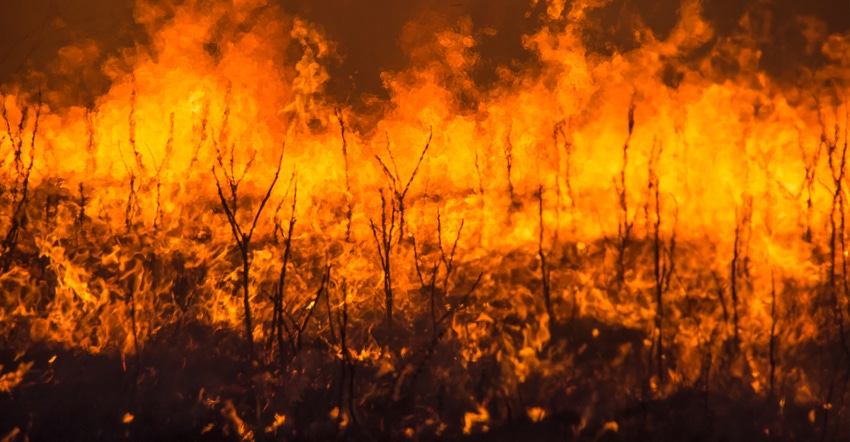
What are two words guaranteed to draw the ire of a cattle producer? Serecia lespedeza.
This invasive plant has evolved defenses and plant characteristics to be almost unkillable in native grass pastures. While young plants may be nibbled on by cattle, mature serecia will grow woody and have high tannins that make it distasteful. It has a high tolerance to insect pests and is a prolific seed producer, which means it could possibly grow on the moon if given the chance.
Cattle producers have resigned themselves to using short-term chemical control, applied in June or the September, but those only control about 90% of the growing serecia, and don’t even touch the seed reservoir on the surface of the ground.
Getting ahead of the problem is something KC Olson has spent a lot of time contemplating as a cattle producer and as an academic. Olson is a Kansas State University professor of range beef cattle nutrition and management. He spoke at the 2022 KSU Stocker Beef Cattle Field Day, Sept. 29, in Manhattan, about research into using fire to control this invasive species.
Critical ecosystem
The Flint Hills tallgrass prairie is an ecosystem like no other, Olson explained. With just 4% of the original 165 million acres left of the Flint Hills tallgrass prairie, it’s vital to manage the ecosystem for its longevity.
“We have 500 different plants, 700 different insects, 40 different mammals — it’s more diverse on a small scale than the Amazon rainforest,” Olson said. The tallgrass prairie is a natural carbon sink, and the flint in the ground that gives the area its name is an excellent water filter.
It’s so good at growing things that invasive species tend to take hold — and not just serecia, but also the Old World-bluestem grasses. Every acre these species take over is an acre out of your carrying capacity, Olson said.
Serecia lespedeza, Olson said, is like a wild hog in this ecosystem. When it was brought to Kansas in the 1930s, it was meant to recover land from strip mining. But it adapted over 70 years, and now it’s a threat. It has deep roots and a canopy that shades out competition; its seeds are not only plentiful, but also can regenerate after 70 years Olson said.
Trying everything
Olson was frustrated with chemical controls of serecia that didn’t do the trick. So he started researching various methods. “I tried co-grazing cows and goats,” Olson said. “But no one wanted goats. Then, I tried sequential grazing of beef steers followed by sheep. But no one wanted to own sheep. So I started to rethink how we use fire.”
Typically, cattle producers burn pastures in the spring, when it’s dry, the fuel load is high and the winds can be unpredictable, Olson said.
His research indicated that that timing of the controlled pasture burn should move to August, when stocker cattle have left the Flint Hills. The fires moved slower, and lopped off the top of the serecia.
A four-year study on the Moyer Ranch in Geary County, without grazing, used three different burn timings on different parts of the ranch: the traditional spring burn, a fire in August and one in early September.
Olson’s team evaluated how much serecia was left after each burn. The spring burn left 7.5% serecia coverage, the August burn left 3% of the serecia and the early-September burn left 2% of serecia.
“The remaining serecia plants were smaller physically — and not only that, every year we applied fire late in the growing season, we got complete suppression of seed production,” Olson said. Those remaining seeds were green, soft and immature, he added.
Fire is a comprehensive and inexpensive treatment, compared to grazing and chemical application, Olson said.
Friendly fire
But what about the other plants out there? What did fall fire do to them?
“Bottom line — very little,” Olson said. “It didn’t change the total biomass accumulation measured in July at all. The regrowth prior to dormancy is substantial.” It didn’t change the cool-season grasses, but it did control the other bothersome perennial forbs, like ironweed and western ragweed. And in another project at a ranch near Kanopolis [Kan.], they found it controlled the invasive Old World bluestems as well.
Even better is that the later fire treatment encouraged a group of about eight species of wildflowers to grow, which are critical food and habitats for beneficial bugs — and the birds that feed on those bugs. The ecosystem, Olson said, stabilizes and returns its more native biodiversity.
A subsequent trial at the KSU Beef Stocker Unit expanded the project to 300 acres per treatment and looked at livestock performance. Olson said there was about 0.10-pound difference in average daily gain among the three fire treatments.
“If you’re worried about giving up 5 to 10 pounds of gain per calf, just think about what you’re spending on herbicide in time and cash,” Olson said. This 75-cent-per-acre fire treatment can replace multiple treatments of herbicides, he added.
To watch his full presentation, see below or visit youtube.com/watch?v=bWy1a1Y9QOo.
About the Author(s)
You May Also Like






